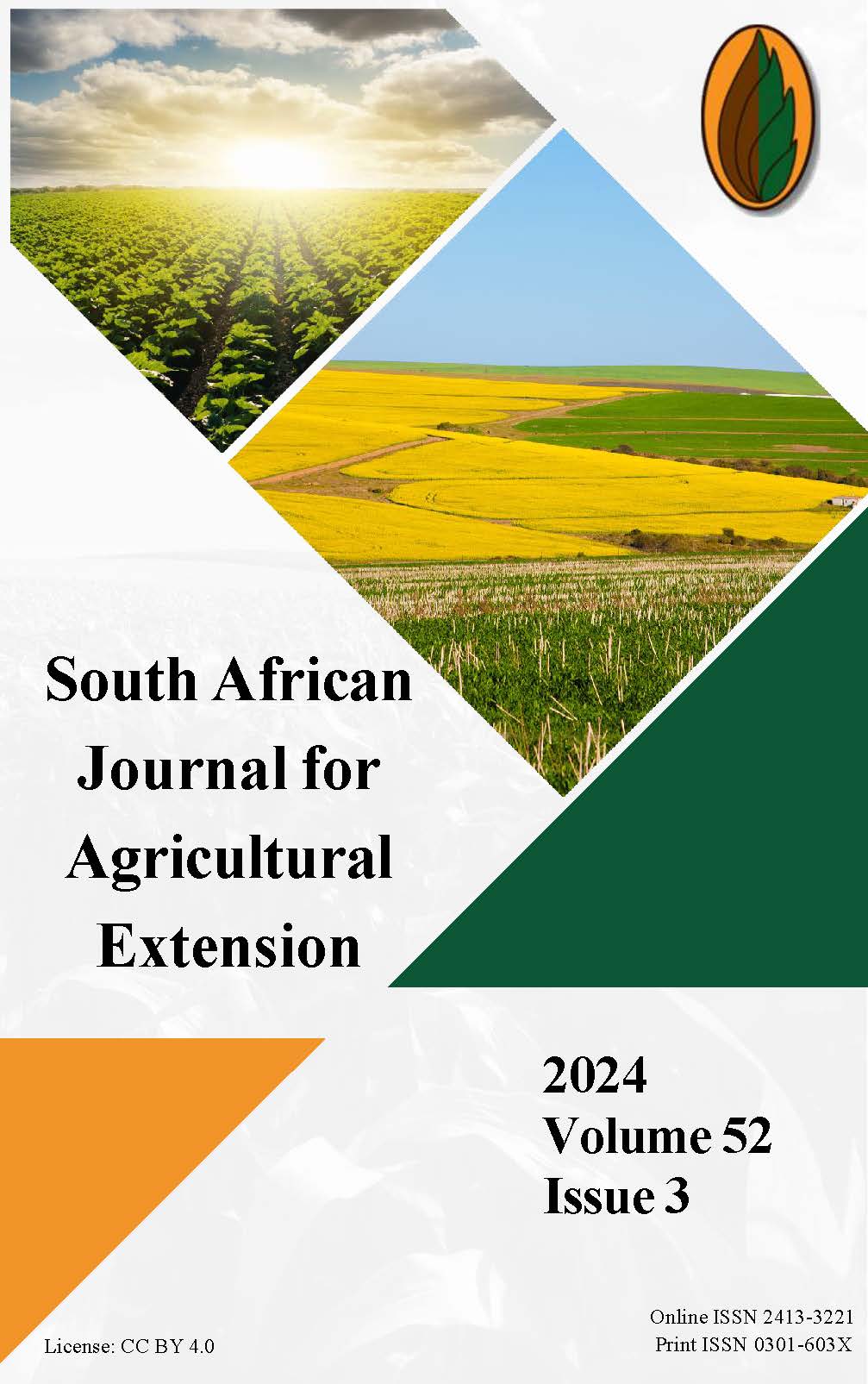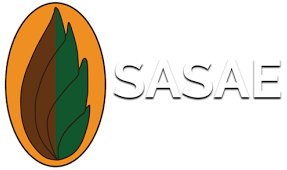Agricultural Extension Practitioners' Use of Information Communication Tools in the Capricorn District, Limpopo, South Africa: A Perception Study
DOI:
https://doi.org/10.17159/2413-3221/2024/v52n3a15904Keywords:
Agricultural Extension Practitioner, Communication, Information, Perception, Technology, Tools, Adoption BehaviourAbstract
Perception is a critical concept in innovation adoption. Reports from the Limpopo Department of Agriculture and Rural Development indicate that agricultural extension practitioners (AEPs) do not use the full complement of Information, Communication and Technologies (ICTs) made available for their extension work. This can compromise the effectiveness of extension service delivery to farmers. This study applied the Düvel adoption behaviour analysis framework to help understand the AEPs' perceptions and use of ICTs made available to them for their work. Using a self-administered questionnaire and adopting a census approach, data was collected from the AEPs in two local municipalities of the Capricorn district. Data was analysed by descriptive statistics. The findings indicate that most AEPs have a favourable perception of the ICTs made available to them for their work. Furthermore, the study found factors that are incompatible with the present situation of AEPs that constrain the use of all the ICTs. These findings have important implications for delivering effective extension services to farmers. The study results also show that the Düvel behaviour analysis framework consistently yields results congruent with theoretical expectations. This enriches the extension theory. To solve incompatibility challenges, recommendations are made based on the findings.
Downloads
References
ABDULLAHI, A., GARFORTH, C.J. & DORWARD, P.T., 2013. Enhancing extension roles through mobile phones in Nigeria: A case study. 21st European Seminar on Extension Education / Extension Education Worldwide, 2-6 September, ANTALYA. Available from: https://www.tandfonline.com/doi/abs/10.1080/1389224X.2013.768069
AFFUL, D.B., OBI, A. & LATEGAN, F.S., 2013. The relative attractiveness of payment for the delivery of public extension visits. J. Dev. Agric. Econ., 5(12): 490-498.
AFFUL, D.B., 1995. Human constraints in stock reduction in a subsistence farming situation in South Africa. Master's dissertation. University of Pretoria, South Africa.
AGWU, A.E., UCHE-MBA, U.C. & AKINNAGBE, O.M., 2008. Use of information communication technologies (ICTs) among researchers, extension workers and farmers in Abia and Enugu States: Implications for a national agricultural extension policy on ICTs. J. Agric. Ext., 12(1): 37-49.
AJAYI, A.O., 2006. An assessment of farmers' willingness to pay for extension services using the contingent valuation method (CVM): The case of Oyo State, Nigeria. J. Agric. Educ. Ext.,12(2): 97-108.
AJAYI, A.O., ALABI, O.S & AKINSOLA, T.O., 2013. Knowledge and perception of extension agents on information and communication technologies (ICTs) use in extension service delivery in Ondo State, Nigeria. Afr. J. Agric. Res., 8(48): 6226-6233.
AKUKU, B., MAKINI, F., WASILWA, L., MAKELO, M. & KAMAU, G., 2014. Application of innovative ICT tools for linking Agricultural research knowledge and extension services to farmers in Kenya. Kenya Agricultural Research Institute. Available from: https://repository.ubuntunet.net/bitstream/handle/10.20374/139/akukub2- presentation.pdf?sequence=2&isAllowed=y
ANNOR-FREMPONG, C., 2013. The influence of intervening variables and subjective norms on the adoption behaviour of small-scale farmers in South Africa and Lesotho. Doctoral thesis. University of Pretoria, South Africa.
ANTWI-AGYEI, P. & STRINGER, LC., 2021. Improving the effectiveness of agricultural extension services in supporting farmers to adapt to climate change: Insights from northeastern Ghana. Clim. Risk Manage., 32: 1-13.
ASENSO-OKYERE, K. & MEKONNEN, D.A., 2012. The Importance of ICTs in the provision of information for improving agricultural productivity and rural incomes in Africa. Available from: https //www.researchgate.net/publication/259256522_The_Importance_of_ICTs_in_the_Provision_of_Information_for_Improving_Agricultural_Productivity_and_Rural_Incomes_in_Africa
DAVIS, K.E. & ASENSO-OKYERE, K., 2010. Innovative models of agricultural extension: Global perspectives and implications for Indian system. India: Naarmifpri.
De VILLIERS, R., 2012. The implementation of ICT in agriculture and rural development in South Africa. Available from: https://www.slideshare.net/Nawsheen_Hosenally/021-de-Villiers.
DEPARTMENT OF AGRICULTURE, FORESTRY AND FISHERIES., 2011. National Framework for Extension Recovery Plan. Pretoria: Government Printers.
DEPARTMENT OF AGRICULTURE., 2005. Norms and Standards for Extension and Advisory Services in Agriculture, Scientific Research and Development Directorate. Pretoria: Government Printers.
DERSO, D. & EJIRO, E., 2015. The contribution of information communication and technologies to the Ethiopian agricultural extension system: A review of literature on agricultural knowledge management. Afr. J. Agric. Sci. Technol., 3(9): 407-411.
DÜVEL, G.H., 1991. Towards a model for the promotion of complex innovations through programmed extension. S. Afr. J. Agric. Ext., 20: 70-86.
DÜVEL, G.H., 1975. The mediating function of perception in innovation-decision. S. Afr. J. Agric. Ext., 4: 31-37.
GERSHON, F., WILLETT, A. & ZIJP, W., 1999. Agricultural extension: generic challenges and some ingredients for solutions. Washington, DC: The World Bank.
GILWALD, A., STORK, C. & MILEK, A., 2010. Gender assessment of ICT access and usage in Africa. Towards evidence-based ICT policy and regulation. Policy Paper 5. Available from: http://lirneasia.net/wp-content/uploads/2010/09//Gender_Paper_Sept_2010.pdf
GLEN, S., 2013. Large enough sample condition. Available from: http://www.statisticshowto.com/large-enough-sample-condition/
HATFIELD, G., 2001. Perception: History of the Concept. Available from: https://doi.org/10.1016/B0-08-043076-7/00137-6
HUDSON, D. & HITE, D., 2003. Producer willingness to pay for precision application technology: Implications for government and the technology industry. Can. J. Agr. Econ., 51: 39-53.
ISRAEL, G.D. & WILSON, K.M., 2006. Sources and channels of information used by educational program clients. J. Appl. Commun., 90(4): 55-78.
KANTE, M., OBOKO, R. & CHEPKEN, C., 2016. Factors affecting the use of ICTs on agricultural input information by farmers in developing countries, AIMS Agric. Food., 1(3): 315-329.
KAUSHIK, P.D. & SINGH, N., 2004. Information technology and broad-based development: Preliminary lessons from North India. World Dev., 32: 591-607.
KOPECKY, F., 2016. The introduction of smartphones as a tool for agricultural extension in rural Uganda: A three-phase study. Master's thesis. Iowa State University.
LANE, J., n.d. Presentation on digital pen project managed by South African Ministry of Agriculture in partnership with Xcallibre. Available from: https://slideplayer.com/slide/9235336/
LEEUWIS, C. & VAN DAN BAN, A., 2004. Communication for rural innovations: Rethinking agricultural extension. 3rd edn. Oxford: Blackwell Publishing.
MABE, L.K. & OLADELE, O.I., 2012. Use of information communication technology tools among agricultural extension officers in the North-West province, South Africa. Life Sci., 9(4): 3275-3279.
MALEKA, M.B.M., 2011. A gender-based analysis of ICT adoption and usage in South Africa. Master's dissertation. University of the Witwatersrand, South Africa.
MATTO, G., 2018. Agricultural information access and the use of ICTs among smallholder farmers: A case of Bembeke EPA in Dedza District, Malawi. Research Report., 2(1): 59-72.
MCDONALD, S.M., 2011. Perception: A concept analysis. Int J Nurs Knowl., 23(1): 2-9.
MCNAMARA, K., BELDEN, C., KELLY, T., PEHU, E. & DONOVAN, K., 2011. Overview of ICT in agriculture: Opportunities, access, and cross-cutting themes. In ICT in Agriculture. Washington, D.C: The World Bank, InfoDev and ARD, pp 1–14.
MSUYA, C.P., 2016. The comparative role of independent and intervening variables on influencing the adoption of nitrogen fertilization among maize growers in the Njombe District. S. Afr. J. Agric. Ext., 44(2): 1-18.
MUGWISI, T., 2013. The information needs and challenges of agricultural researchers and extension workers in Zimbabwe. Doctoral thesis. University of Zululand, South Africa.
MUSTAPHA, S., MAN, N., ARIF SHAH, J., HIRAWATY KAMARULZAMAN, N. & ABUBAKAR TAFIDA, A., 2022. Mediating role of motivation in the relationships between awareness, accessibility, perceived organizational support and adoption of ICT among extension agents in North-East, Nigeria. J. Agr. Sci. Tech., 24(6): 1313-1329.
OLADELE, O.I., 2015. Effect of information communication technology (ICT) on agricultural information access among extension officers in North-West province South Africa. S. Afr. J. Agric. Ext., 43(2): 30-41.
ROGERS, E.M., 1983. Diffusion of innovations. 3rd edn. New York: The Free Press.
ROHILA, A.K., YADAV, K. & GHANGHAS, B.S., 2017. Role of information and communication technology (ICT) in agriculture and extension. J. Appl. Nat. Sci., 9(2): 1097-1100.
SALA, S., ROSS, F. & DAVID, S., 2016. Supporting agricultural extension towards climate-smart agriculture-an overview of existing tools: Compendium. Rome: FAO. Available from: http://www.fao.org/3/a-bl361e.pdf
SAMANSIRI, B.A.D. & WANIGASUNDERA, W.A.D.P., 2014. Use of information and communication technology (ICT) by extension officers of the Tea Small Holdings Development Authority of Sri Lanka. Trop. Agric. Res., 25(4): 460-475.
SEBEHO, M.H., 2016. Perceptions and attitudes of farmers and extensionists towards extension service delivery in the Free State province, South Africa. Master's dissertation. University of Pretoria, South Africa.
SOUTH AFRICAN GOVERNMENT., Employment Equity Act 55 of 1998. Available from: https://www.gov.za/documents/employment-equity-act
STATISTICS SOUTH AFRICA., 2016. Vulnerable groups Series I: The social profile of the youth, 2009‐2014. Available from: http://www.statssa.gov.za/publications/Report-03-19-01/Report-03-19-012014.pdf
SULAIMAN, R. & SADAMATE, V.V., 2000. Privatizing agricultural extension in India Policy Paper 10. New Delhi: National Centre for Agricultural Economics and Policy Research (NCAP).
TATA, J.S. & MCNAMARA, P.E., 2016. Social factors that influence the use of ICT in agricultural extension in Southern Africa. Agriculture., 6(15): 1-10.
TELG, R. & IRANI, T., 2012. Agricultural communications in action: A hands-on approach. New York: Delmar Cengage Learning.
THOMAS, W.I. & ZNANIECKI, F., 1927. The Polish peasant in Europe and America. New York: Knopf.
TORNATZKY, L.G. & KLEIN, K.J., 1982. Innovation characteristics and adoption- implementation: A meta-analysis of findings. Ieee T Eng Manage., 29: 28–45.
TRENDOV, N.M., VARAS, S. & ZENG, M., 2019. Digital technologies in agriculture and rural areas. Status report. Rome. Available from: http://www.fao.org/3/ca4985en/ca4985en.pdf
Downloads
Published
Issue
Section
License
Copyright (c) 2024 D.B. Afful, P.P. Mabena

This work is licensed under a Creative Commons Attribution 4.0 International License.








.png)